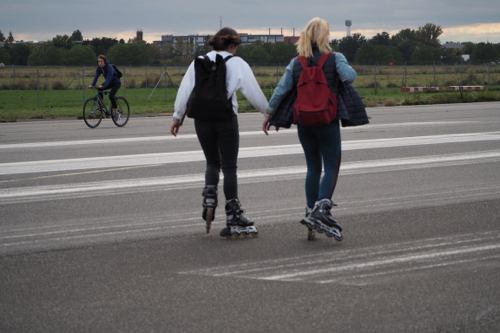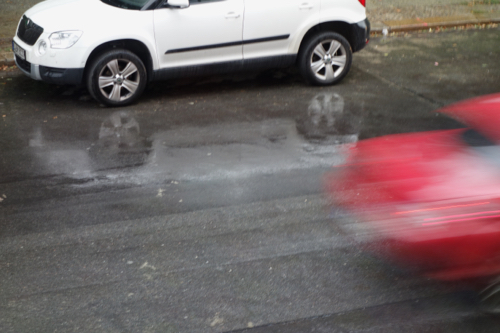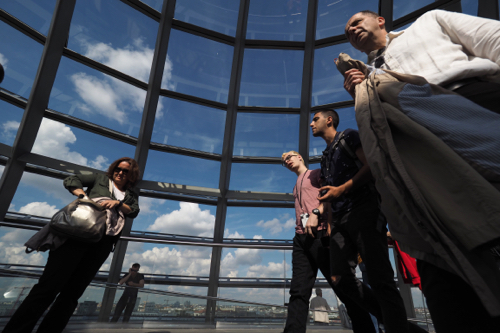September 11, 2017. Poznań, Poland to Berlin, Germany.
We were returning back to Berlin to relax, catch up on things and spend some more time with Hayden and Andrea.
On reaching Berlin we detoured to Templehof Airfield.
Up until 2008, when it ceased operating, Templehof was one of the main airports in Berlin.
It is now a vast playground for the Berliners, and is now known as Templehofer Feld.
It was a cold and windy afternoon when we arrived at Templehofer Feld but there were hundreds, if not a thousand people walking, riding, playing, kite flying or just hanging out.
Because of its vastness it was difficult to estimate just how many people were there.
Currently there is 386 hectares of open space available to the public.
The original terminal was constructed in 1927 and in the mid 1930s the Nazi government started a massive redevelopment.
As part of the Soviet blockade of Berlin in 1948, Templehof became the lifeline of Berlin. For 11 months vital supplies were airlifted into the isolated city. The Berlin Airlift is now regarded as one of the greatest feats of aviation history.
To keep West Berlin supplied, over 200,000 flights delivered 8,893 tons of necessities into the city.
September 12, 2017. Berlin, Germany.
Over the next few days we took off our tourist hats and just became Berliners.
We did have a walk around Volkspark Friedrichshain and Alexanderplatz but that was about it. I didn’t even take any photos for two days.
September 13, 2017. Berlin, Germany.
The highlight of the day was a haircut and visit to the Post Office, not to post anything but to get money. There are very few banks near Hayden and Andrea’s apartment.
September 14, 2017. Berlin, Germany.
It had been raining on and off since we returned to Berlin so we were confined indoors for much of the time. We really didn’t care as this was our time for R&R.
I took a photo for the first time in days it was of the rain in Saarbrücker Straße from our apartment window.
September 15, 2017. Berlin, Germany.
We were back to being tourists, but only for a few hours.
After getting the Renault washed, and it needed it badly after the bug splattering of the last six weeks, we headed off to do some sightseeing.
Berliner Mayer East Side Gallery is a 1,316 meter long section of the Berlin Wall that has been preserved as a memorial to freedom.
The gallery contains 105 paintings of artists from all over the world. Sadly many have been damaged by vandalism and tagging. This is a shame as the gallery attracts over 3 million visitors a year.
Some sections have been removed and others partly demolished.
There is still a major conflict regarding the gallery.
One of the most famous pieces is the Socialist Fraternal Kiss between Erich Honecker and Leonid Brezhnev, titled: My God, Help Me to Survive This Deadly Love.
On the other side of the gallery is part of the Wall Museum. This currently has on display a series of documentary style installations recounting experiences of victims from East Berlin.
September 16, 2017. Berlin, Germany.
It was the weekend, so after a late breakfast we went strolling around the area near Hayden and Andrea’s apartment.
This was not the tourist areas but the places that Berliners frequent on the weekend.
September 17, 2017. Berlin, Germany.
The sun was out and so were the people.
Our tourist outing for the day was a visit to the Reichstag or German Parliamentary building on the edge of Tiergarten Park and next to the Brandenburg Gate.
Hayden and Andrea had booked us passes to visit the dome. There is no entrance fee but you have to book in advance.
We did and so did many others – the place was packed.
There was a touch of irony in our visit, as next week the Germans go to the polls.
A very important vote for both them and Europe.
The Reichstag was originally built in 1884 and designed by architect Paul Wallot, after a competition.
It housed the German Parliament until 1933, when it was badly damaged by fire that swept through the original dome.
Hitler blamed the fire on the Communists and this was a catalyst for many reforms that gave him the power to rule Germany as a dictatorship.
After the war it fell into disuse as Germany was now divided between the east and the west.
When Germany was reunified in 1990 it was decided that the German Parliament should again sit in the Reichstag.
In 1993 again a competition was held, calling for new designs, and was won by the British architect Norman Foster. The building then underwent reconstruction between 1995 and 1999.
The new dome was a feature of the design.
Foster, under a brief from the German Parliament, built the new dome as a symbol of Germany’s unity and ‘Transparent Politics’ in contrast to the Nazis and the Soviets.
The large glass and steel dome has great views of the surrounding city and you can look into the space below.
The new dome covers the main debating chamber of the Bundestag and incorporates a number of high-tech features. A mirrored cone, in the centre of the dome, directs sunlight into the chamber, reducing carbon emissions by saving on power. While a sunshield tracks the sun and blocks out the direct sunlight and associated heat.
Norman Foster has been responsible for many ground breaking designs over the years.
Some that I recall and admire are the HSBC Building in Hong Kong, the ‘Gherkin’ in London and the world’s tallest bridge, the Millau Viaduct in France.
He was also involved, with the late Steve Jobs, in designing the new Apple Park, or ‘Spaceship’ in Cupertino, California.
After the Bundestag we walked to the Soviet War Memorial in the Tiergarten. It was constructed just after war ended in 1945 and designed by Lew Kerbel. It is in remembrance of the 2,000 Russians who died fighting to ‘free’ Berlin.
These were our last days in Germany and Europe.
It was the end of our Baltic adventure, we were now headed to a more familiar place – England.













